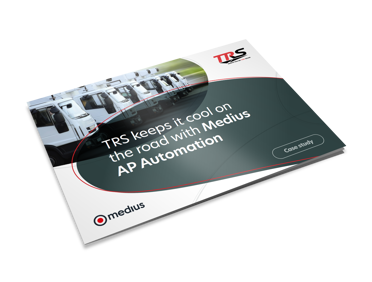Reduce accounting errors & data inaccuracy with automation
Are you aware that a significant portion of financial discrepancies in businesses stem from manual accounting processes? The margin for error in accounting operations is more narrow than ever. With billions of dollars at stake globally due to financial mismanagement, how can your business leverage technology to protect against these costly errors and ensure operational efficiency?
Leveraging the latest in tech, businesses are poised to slash manual mishaps, uphold the sanctity of their financial records, and boost their operational agility. Our deep dive into AP automation highlights its role in not just rectifying but preempting the costly blunders inherent in financial processes. Automation helps streamline financial operations, equipping companies to tread this complex environment with assured accuracy and unmatched efficiency.
The high cost of accounting errors
Every transaction in business carries weight, and in the delicate balance of accounting and accounts payable, errors—no matter how small—can lead to substantial financial repercussions. These missteps can ripple through the financial health of an organization, leading to a cascade of adverse outcomes.

Direct financial impact
The most immediate consequence of accounting errors is the direct financial loss. This can manifest as overpayments, underpayments, late payment fees, and missed opportunities for early payment discounts. Each error, while seemingly minor on its own, can accumulate into a significant financial burden over time. The cumulative effect can be startling, with businesses potentially losing thousands to millions of dollars annually due to these accounting inaccuracies.
Vendor relationships & operational inefficiencies
The impact of accounting errors extends beyond direct financial loss, significantly affecting vendor relationships and operational efficiency. Late payments or invoicing inaccuracies can strain partnerships with suppliers, leading to less favorable terms and potentially compromising your business’s market competitiveness. The need to correct such errors also consumes valuable time and resources, detracting from core business activities. This leads to reduced productivity and increases in operational costs.
In situations where errors are common, the ongoing need to address these issues can result in employee burnout, further undermining the efficiency and morale of your team. By prioritizing accuracy in AP processes, businesses can maintain robust vendor relationships and streamline operations, ensuring a stable and efficient financial ecosystem.
Reputational damage
In severe cases, consistent accounting errors can tarnish a company's reputation. For publicly traded companies, inaccuracies in financial reporting can lead to a loss of investor confidence, affecting stock prices and market valuation. For private companies, the repercussions may not be as publicly visible but can be equally damaging through lost business opportunities and diminished trust among partners and clients.
Legal and regulatory repercussions
Finally, accounting errors can lead to legal and regulatory complications. Failure to comply with financial reporting standards, tax laws, and regulatory requirements can result in hefty fines, penalties, and in extreme cases, legal action. The cost of compliance failures extends beyond financial penalties, affecting a company's standing with regulatory bodies and its ability to operate within certain jurisdictions.
Common sources of accounting errors
Accounting errors often stem from seemingly minor oversights or systemic issues within the accounting processes, but their impacts can be far-reaching. Below we discuss the more common sources of these errors and how they compromise the integrity of financial data.
Data entry mistakes
At the forefront of accounting inaccuracies are data entry mistakes. These errors occur during the manual input of financial information into accounting systems. Simple typos, transposing numbers, or omitting crucial details can lead to significant discrepancies in financial records, affecting everything from balance sheets to tax filings.
Errors of omission
Failing to record a financial transaction is an error of omission. This can happen when invoices are misplaced, or transactions are overlooked. Such omissions distort the financial standing of a business, leading to inaccurate financial statements and potentially flawed decision-making based on incomplete data.
Outdated or incorrect data
Relying on outdated or incorrect information for financial decisions or reporting can lead to errors. This may include using old vendor details, incorrect pricing, or outdated financial models. The dynamic nature of business necessitates regular updates to databases and systems to ensure the accuracy of financial records.
Misclassification of expenses
Incorrectly categorizing expenses can have implications for financial reporting and tax calculations. Misclassification may lead to inappropriate tax deductions or misstated financial results, affecting profitability and compliance with accounting standards.
Overreliance on manual processes
Manual accounting processes are inherently prone to human error. The more a task requires manual input or intervention, the higher the risk of mistakes due to fatigue, distraction, or misunderstanding. Automation and digitization of these processes significantly reduce the likelihood of such errors.
Complex financial instruments
The complexity of financial products and services can be a source of accounting errors, especially in organizations that engage in sophisticated financial transactions. Understanding and accurately accounting for these instruments require specialized knowledge and attentiveness to prevent errors.
Lack of reconciliation
Regular reconciliation of accounts ensures that internal records match external statements, such as bank accounts. Failure to perform timely reconciliations can allow errors to persist undetected, compounding over time and complicating the task of rectification.
By identifying these common sources of accounting errors, businesses can take proactive steps to mitigate their occurrence. Implementing robust AP automation solutions addresses many of these challenges, streamlining data entry, ensuring up-to-date information, facilitating accurate classification, and enabling regular reconciliations. Through technological intervention, the accuracy and reliability of accounting processes are significantly enhanced, safeguarding the financial health and operational integrity of organizations.
To see the impact of AP automation on reducing accounting errors, look at TRS's experience in our case study. After integrating Medius's solutions, TRS not only minimized manual data entry errors but also improved overall operational efficiency. This example underscores the power of technology in transforming accounting processes.
The role of automation in reducing accounting errors
AP automation technology has emerged as a vital tool in the fight against accounting errors. This technology reshapes traditional processes, embedding precision and efficiency at every turn. Here’s how automation helps fight against the common pitfalls that plague accounting operations:
Automation technologies utilize advanced algorithms and optical character recognition (OCR) to extract and process data from invoices and other financial documents. This significantly reduces manual data entry, a notorious source of errors such as typos, transpositions, and omissions. Automated systems ensure that data is captured accurately, consistently, and without the fatigue-induced mistakes that human operators can make.
Beyond data capture, AP automation systems incorporate layers of verification and validation to ensure the integrity of financial information. These systems cross-reference incoming data against existing records for discrepancies, automatically verifying vendor information, payment terms, and amounts. By doing so, they minimize the risk of overpayments, duplicate payments, and fraudulent transactions.
One of the standout features of AP automation is its ability to detect errors proactively. Through predefined rules and machine learning algorithms, these systems can identify anomalies, inconsistencies, and patterns indicative of potential errors. Once detected, automation solutions can flag these issues for human review or correct them based on preset criteria, ensuring that errors are addressed before they escalate into costly problems.
Automation ensures that all transactions are processed in accordance with internal policies and regulatory requirements. This consistency is critical for compliance, reducing the risk of financial penalties associated with manual errors in reporting and documentation. AP automation also provides comprehensive audit trails, enhancing transparency and accountability across financial operations.
By automating routine and repetitive tasks, businesses can allocate human resources to more strategic, analytical roles where human insight adds value. This shift not only enhances job satisfaction and reduces burnout but also decreases the likelihood of errors born from monotony and fatigue.
With AP automation, businesses gain access to real-time financial data, enabling more informed decision-making. This immediacy helps identify and rectify errors swiftly, preventing them from affecting financial statements or operational decisions. Analytics capabilities also allow for trend analysis, helping to anticipate and mitigate potential errors before they occur.
AP automation acts as a comprehensive solution to the diverse problem of accounting errors. By integrating these systems, companies can protect their financial processes against data inaccuracies, ensuring a stronger, more resilient financial foundation. This technological embrace not only mitigates the risk of errors but also propels businesses toward a future where financial operations are seamless, transparent, and, most importantly, accurate.
Advancements in automated data entry
Rapid shifts in technology continually redefine the accuracy and efficiency of accounts payable processes. Highlighting this evolution, here are some of the latest technological advancements that automation systems are benefiting from, ensuring unparalleled precision in financial operations.
- Machine learning & artificial Intelligence (AI): These technologies are at the forefront, enabling smarter, self-learning systems that improve over time. They excel in pattern recognition, predicting potential errors before they occur, and automating complex decision-making processes for invoice processing and data entry tasks.
- Cloud-based solutions: Offering real-time data access and seamless updates, cloud-based platforms ensure that financial data is always current and accessible from anywhere. This facilitates immediate correction of discrepancies and supports a more agile financial operation.
- Integration capabilities: Modern AP automation tools are designed to integrate smoothly with existing financial systems and software, creating a cohesive ecosystem that reduces data silos and improves overall data accuracy.
By embracing these technologies, businesses can significantly enhance the precision of their accounting entries and minimize errors, paving the way for more reliable and efficient financial reporting.
Strategies to minimize data inaccuracies
Reducing data inaccuracies in accounts payable and accounting operations is essential for maintaining financial integrity and operational efficiency. Here are strategic measures that can complement the latest AP automation technologies to ensure data accuracy:
Keep staff updated on new technologies and best practices. Ongoing education can help employees understand the importance of accuracy and how to best utilize automation tools.
Use automation systems to set up validation rules that automatically check data for common errors before processing. This can include verifying vendor information against a master database or checking for duplicate entries.
Even with advanced automation, implementing a human oversight layer can add an extra level of scrutiny. This could involve a secondary review of automated data entry by a team member, ensuring any anomalies are caught.
Create standardized procedures for data entry and processing. Consistency in how data is handled can reduce the likelihood of errors and make it easier to identify when inaccuracies do occur.
Utilize analytics tools within AP automation systems to identify patterns that may indicate recurring inaccuracies. This can help pinpoint areas needing process adjustments or additional controls.
Encourage a workplace environment where attention to detail is valued and recognized. Creating channels for feedback on data accuracy issues and celebrating improvements can motivate teams to maintain high standards.
Periodically review and update your AP automation system to ensure it's equipped with the latest accuracy-enhancing features. Regular audits can also help identify any misuse or misconfiguration of the system that could lead to inaccuracies.
By integrating these strategies with the latest in AP automation technology, businesses can significantly minimize the risk of data inaccuracies, leading to more reliable financial reporting and decision-making processes.
Take your accounting to the next level with Medius automation
Minimizing accounting errors and boosting data accuracy are crucial for maintaining a business's financial health. Through advanced AP automation technologies, including AI, cloud-based solutions, and seamless integration capabilities, companies like yours can significantly reduce the risk of costly inaccuracies. Medius's cutting-edge solutions exemplify this potential, offering a clear path to streamlined financial operations.
A testament to the effectiveness of our approach is the success story of TRS, which experienced remarkable improvements in efficiency and accuracy by adopting Medius's AP automation solutions. Their journey is a compelling example of how the right technology can make all the difference in overcoming accounting challenges.
We encourage you to explore how Medius can transform your AP processes. Whether you're looking for a demo, more information on our software, or insights into common AP challenges, we're here to help:
Elevate your AP operations with Medius and join the ranks of businesses achieving unparalleled accuracy and efficiency in their financial processes.









